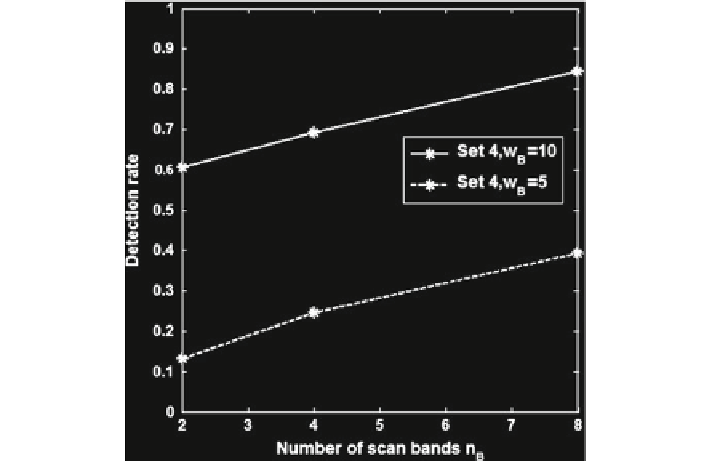Graphics Reference
In-Depth Information
Fig. 10.8
Detection rate versus number of scan bands for Set 4 with circular reflectors
The effectiveness of the proposed technique to detect circular reflectors using the
proposed scan band based lane feature extraction is illustrated in Fig.
10.8
.Itcan
be seen that a detection accuracy of 85% is obtained using 8 scan bands with each
band of 10 pixels. A comparison on the effect of reducing the scan bands and their
width is also shown in Fig.
10.8
. It can be seen that reducing the scan band width
also reduces the detection rate. For the same number of scan bands but scan band
width reduced to 5 pixels, the detection rate has been reduced to about 40%. This is
because thinner scan bands fail to completely and conclusively capture the circular
reflectors. Therefore, having wider scan bands and more number of scan bands to
sample as many reflectors as possible is desirable to get higher accuracy.
An experiment was also conducted to see the effect of changing the scan band sizes
across different scan bands in a single frame. The scan bands nearer to the ego-vehicle
were given higher weight by having thicker bands (
w
B
=
10) as compared to farther
scan bands with
w
B
=
5. Different permutations were used to find if such hybrids can
give better detection accuracy for lesser number of operations. Figure
10.9
shows the
scatter plot with some of these varying options. The option VARY_5_5_5 _10_10_10
is one particularly interesting design option. It gives a detection accuracy of nearly
90%, which is the same as design options with
n
B
=
8 processors for scan band
widths
w
B
=
5 and 10 both. However, it uses only 6 processors instead of 8. In terms
of number of operations, the design option with
w
B
=
5 is better, but this varying
scan band width design option is better choice if we want to reduce the number of
processors.

